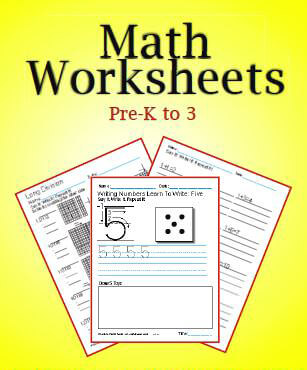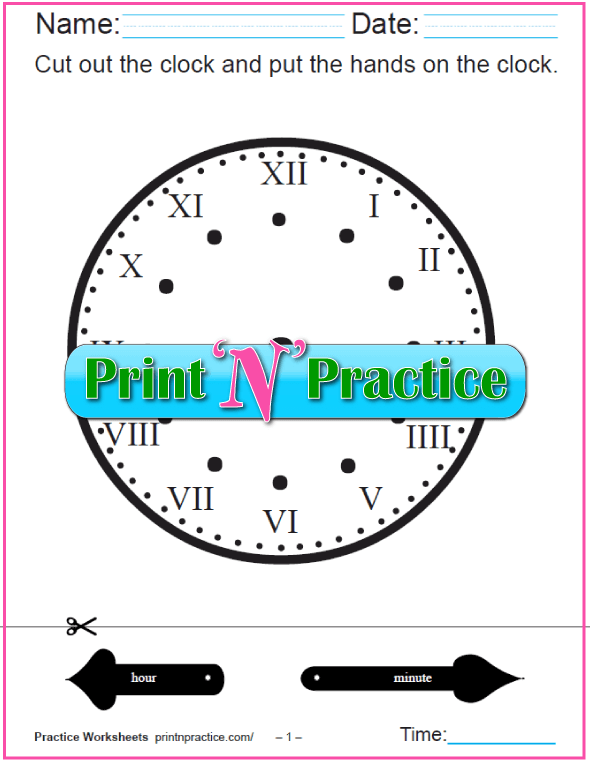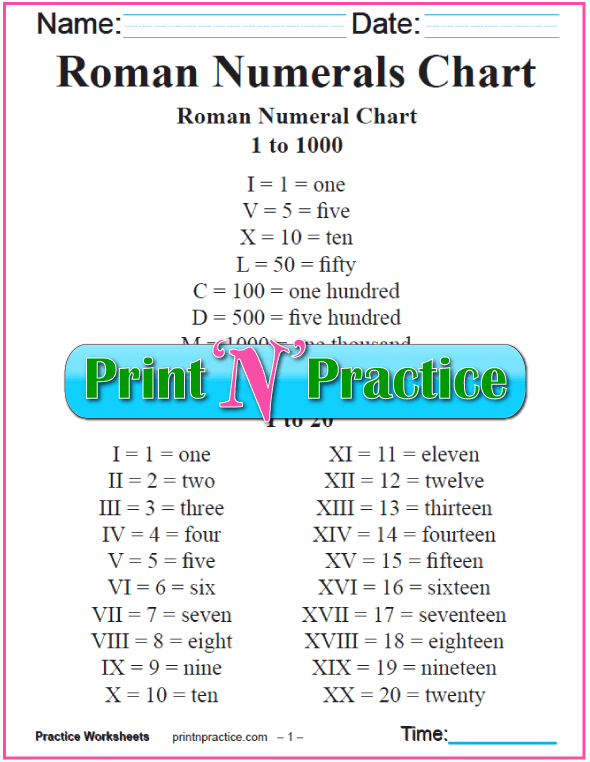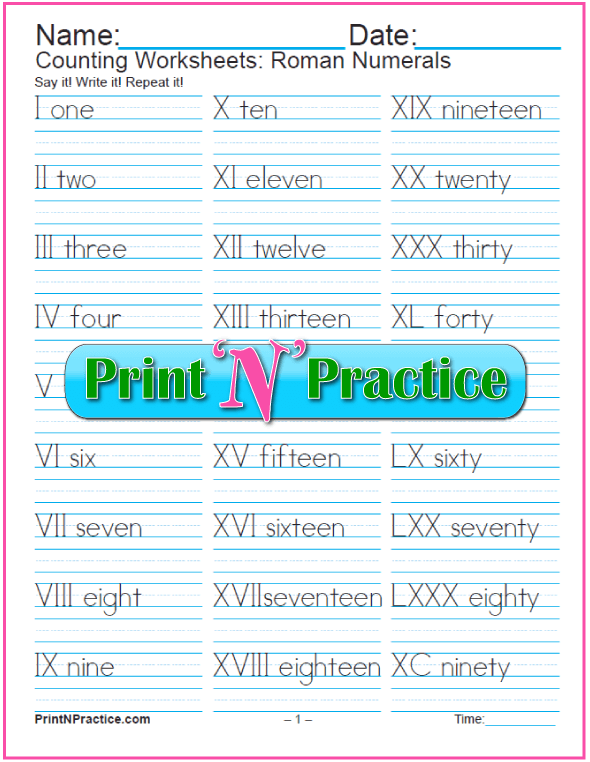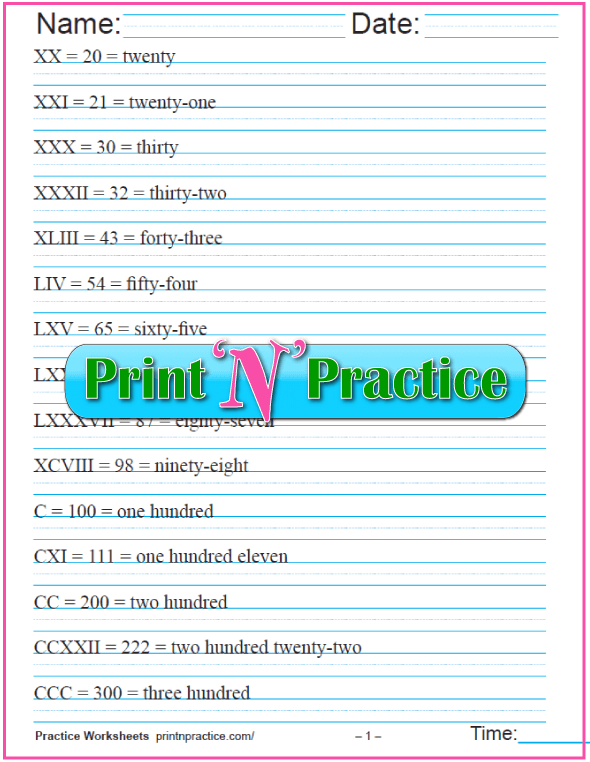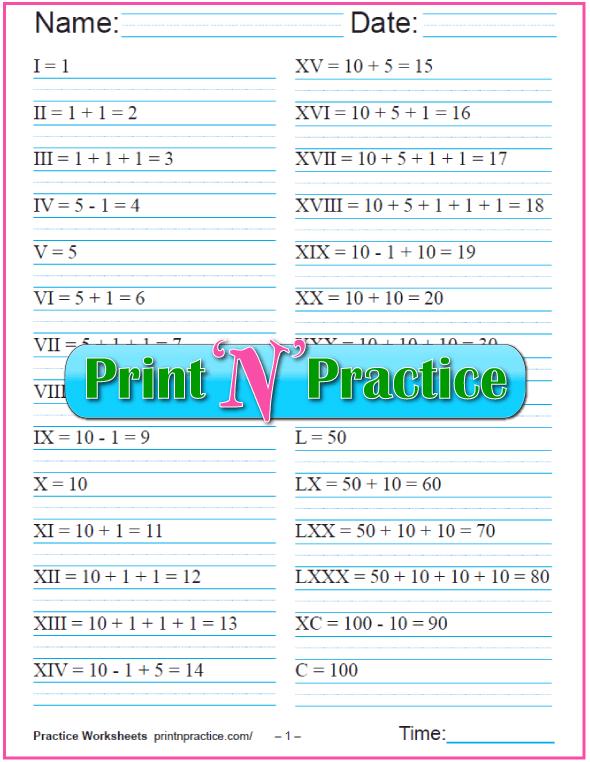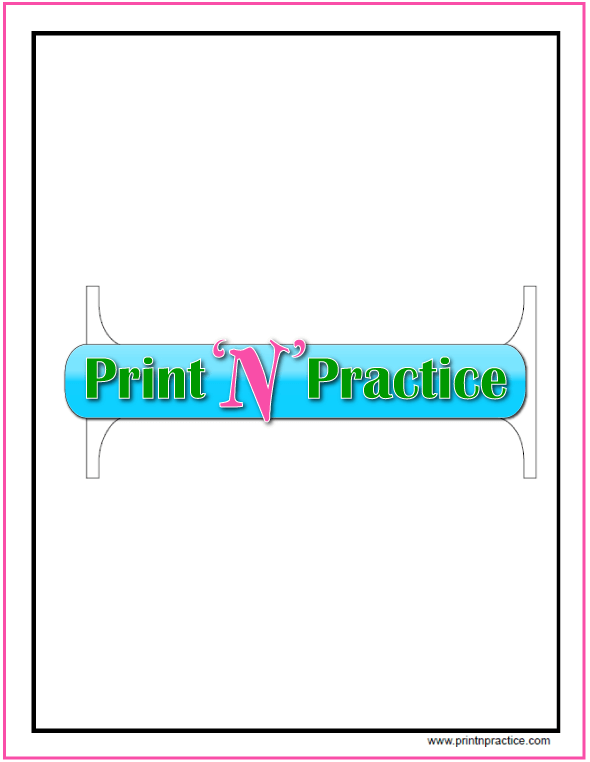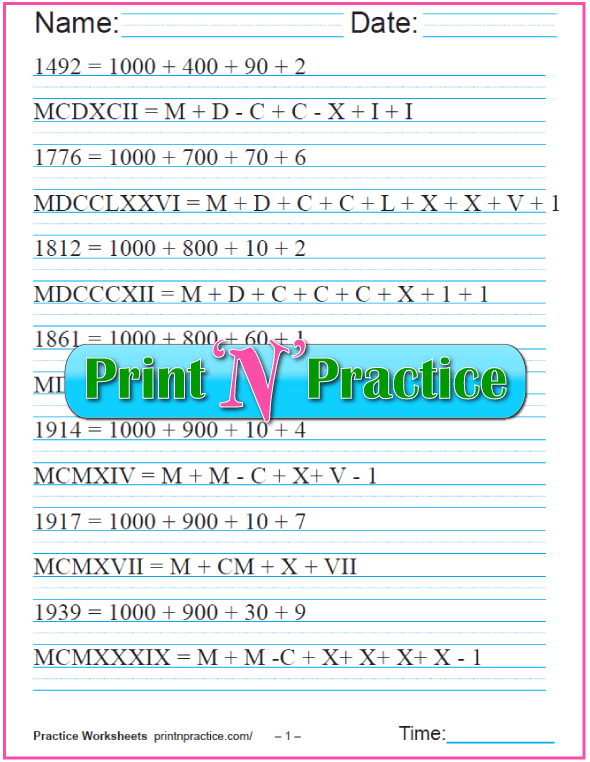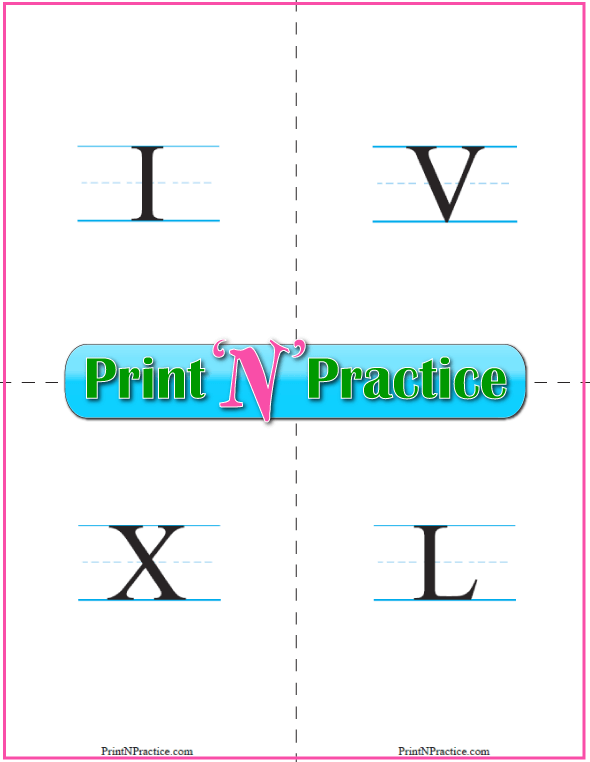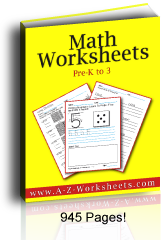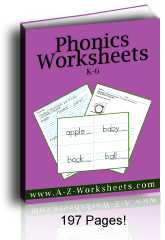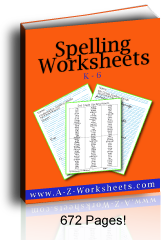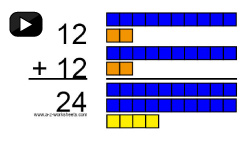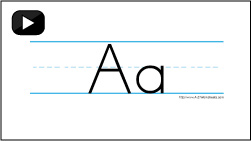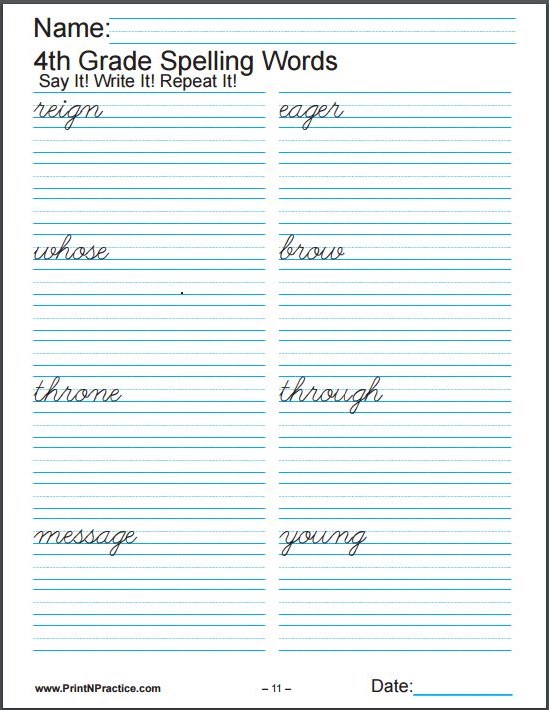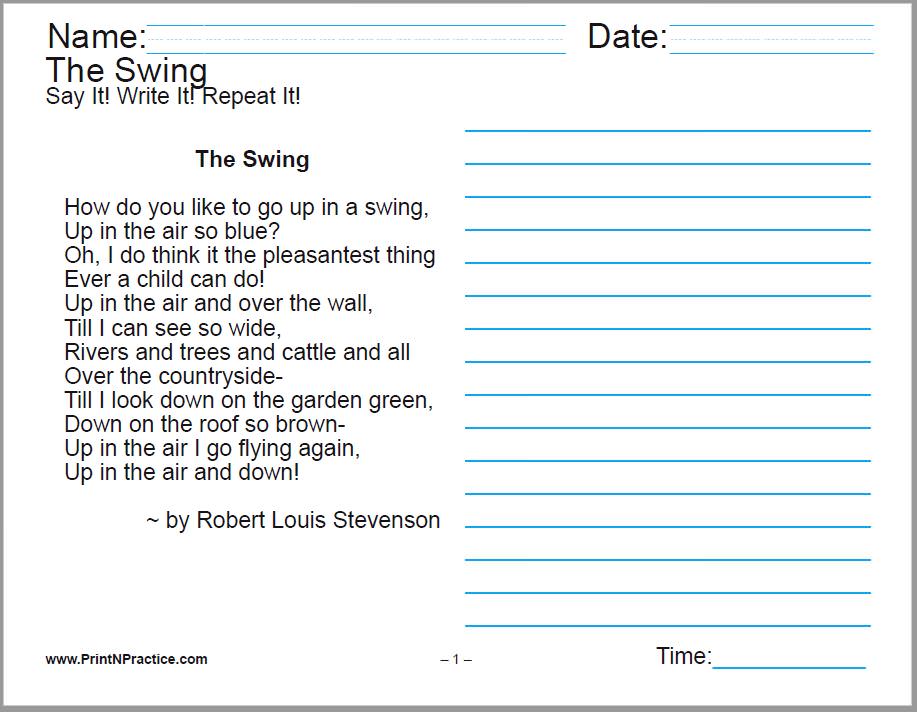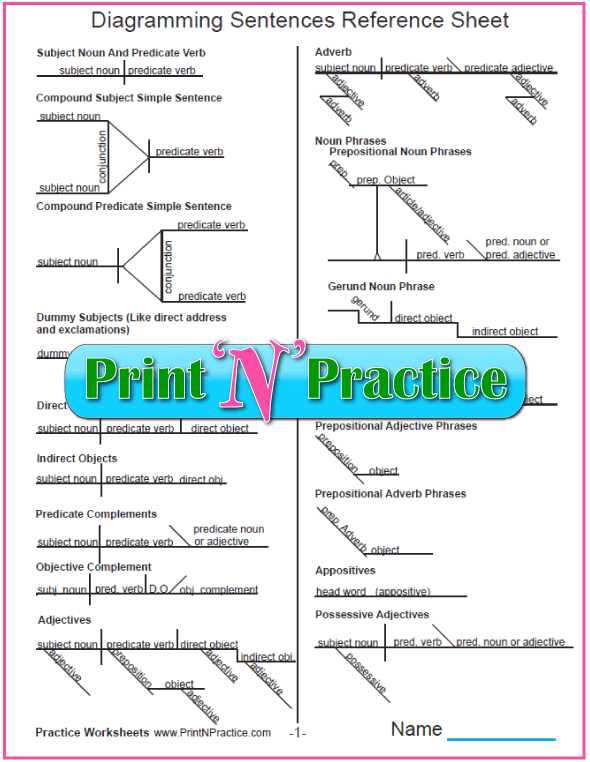- Home
- Math Worksheets
- Roman Numerals Chart
Roman Numerals Chart And
Roman Numeral Conversion Worksheets
Sometimes your math students need a Roman Numerals chart to remember what number goes with which letter.
Keep our printable chart handy for your own memory, too. :-)
- Perhaps the textbook does not explain well enough,
- or does not show the list of equivalents,
- or left out the directions for subtracting when smaller numbers precede larger numbers (see section 4 below),
- or there's no actual practice.
Once kids know the adding and subtracting tricks, they can memorize the values or use the chart for reference.
Once they know how to figure Roman numerals, it's a fun puzzle or math game.
Remembering the "code" is the trick. It's up to you to keep the fun in learning about Roman numbers.
Our printable Math worksheets on this page include a chart, a clock face, and flash cards for teaching Roman numeration or for reviewing Roman numerals. Keep the following chart in your math book or notebook.
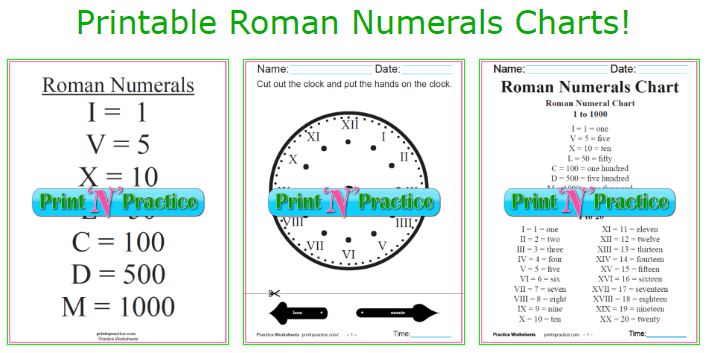 Find our printable Roman Numerals chart selection on this page: Roman Numeral clock faces, charts, copywork, and flash cards.
Find our printable Roman Numerals chart selection on this page: Roman Numeral clock faces, charts, copywork, and flash cards.Do We Still Use Roman Numerals?
First, do we even use Roman numerals in English?
Short answer: Yes.
Long answer: There are many places where Roman numerals are used; especially on buildings, fancy analog clocks, in Bible quotes, and in scientific terms.
It is so fun to hear children exclaim:
- "Hey! Those are on the Olympics!"
- "I've seen those numbers on the Super Bowl!"
Be sure to see the note about the IIII (Roman numeral 4) on Roman numeral clock faces below. How many numerals can you list? Did you know that there are only seven?
You'll also find a bit of the history of Roman numerals on this page.
Worksheets constructing dates are at the bottom of this page.
These Roman numeral worksheets are for both copying the numerals in order and for copying the equations necessary to figure the modern numerical value of the main Roman numerals.
See these worksheets below:
- List of Roman Numerals 1-100 and 1000
- Roman Numeral Conversion
- Numeral Clock Face Worksheet, IV or IIII?
- Printable Roman Numerals Chart
- Printable Roman Numerals Worksheet - Copy Work
- Roman Numerals Popular Dates Practice
- Printable Roman Numerals Flash Cards
When I start to teach Roman numerals to children who haven't previously learned them, they marvel at how often they find them in their everyday lives.
- One will say, "Hey, that's what's on the clock in our living room!";
- Anther, "It's in the beginning of my book.";
- "Neat. That's like the Ten Commandments and Moses.";
- "That's behind my Dad's name."; or
- "My mom uses remedies that have X, C, or M on them."
When we're studying larger numbers using dates they'll say, "I saw that on the brick building in town!" or "That's on our old DVD cases! I always wondered what that was."
It is great fun to teach Roman numerals, especially when you draw a clock and explain the first twelve numerals and how to add and subtract the values. It's always more fun when it seems like we're learning a new code or puzzle! There's a real system to it.
My favorite quote from a student was, "I tried to read those like words and it did not work!" Too cute.
Once your students are familiar enough with addition and subtraction, they can learn how to write Roman numerals quickly. If they can add and subtract up to 100 or 1000, they can learn all of the numerals in just a few lessons. It's like reading and writing in code.
Several Math textbook series that I have used simply repeat the very same Roman numeral lessons year after year. Why? There's very little to learn mathematically speaking.
Literature, History and English Grammar lessons can cover many uses of Roman numerals as with outlines, chapters and volume numbers. These are great to learn for Bible study, too.
When we use a Roman numeral outline in writing composition we use the capital letters first and then the italic or cursive Roman numerals.
Older or handier students can learn the whole list at a glance since there are only seven numerals in the list.
Be encouraged to stay in touch! Join my free newsletter....
Join To Receive My Free PrintNPractice Newsletters!
Free Online Worksheets For School, Homework, And Homeschool Practice
Free Online Teacher Resources - Free Homeschool Curriculum
For teachers and parents: PrintNPractice free printable worksheets are all copyright-free, digital activities for students. Use them in homeschool, interactive notebooks for online classrooms, Google classroom, distance learning, tutoring and learning pods, and hybrid school.
- No prep.
- No tracking.
- Self learning.
- Copyright free.
- Lifetime license.
- Diverse learners.
- Easy drill-and-kill.
- Interactive worksheets.
- Printable morning work.
- Paperless morning work.
- Go printable or paperless.
- Stay on track. Summer review.
- Easy elementary school curriculum.
- Remote learning packets or homework.
- Most need no answer key or key is included.
- Videos for audio and visual learners. God bless headphones!
See free teacher and homeschool digital interactive school-at-home learning exercises with no login, no tracking, no sign-up, no voucher, no account, and no credit card. Loads of digital activities for device-based learning.
1. Printable Roman Numerals List 1-100 and 1000
The first and most basic thing to know about how to read Roman numerals is that they aren't numerals or numbers!
They're an ancient system of Roman letters that represent different values. There are rules to add or subtract these symbols of smaller values to find the full amount.
The Roman numeral for 1 is the capital letter I (i). Roman numeral 10 is an X. 100 is a C. 1000 is simply M. Lower case letters are also used, especially in outlines and on some clocks.
There are only seven Latin letters on the Roman numerals chart. Here is the list of numerals in order with their values:
- I = 1 = one
- V = 5 = five
- X = 10 = ten
- L = 50 = fifty
- C = 100 = hundred - 100 in Roman numerals is C
- D = 500 = five hundred
- M = 1000 = thousand - 1000 in Roman numerals is M
- 945 PDF Math worksheets.
- Buy K-6 in one digital download.
- No ads.
- Filed by topic.
- Interactive. Printable.
- Use with any Math Lesson Plans.
- Addition, Subtraction, Multiplication, Division and Fraction Practice.
2. Roman Numeral Conversion
Roman Numerals 1 Through 10
Roman numeral conversion is easy once you understand the method and even the equation that denotes each number.
I love teaching these with the equations. It's when I hear the most oohs and ahs! "I get it!", "Hey, this is neat!", and "Can we do more of these?"
Hint: One in Roman numerals is a capital letter i.
- Roman numeral 1: I = 1
- Roman numeral 2: II = 1 + 1 = 2
- Roman numeral 3: III = 1 + 1 + 1 = 3
- Roman numeral 4: IV = 5 - 1 = 4 (IIII also 1 + 1 + 1 + 1 =4)
- Roman numeral 5: V = 5
- Roman numeral 6: VI = 5 +1 = 6
- Roman numeral 7: VII = 5 + 1 + 1 = 7
- Roman numeral 8: VIII = 5 + 1 + 1 + 1 = 8
- Roman numeral 9: VIIII = 5 + 1 + 1 + 1 +1 = 9
- Roman numeral 10: X = 10
- 945 PDF Math worksheets.
- Buy K-6 in one digital download.
- No ads.
- Filed by topic.
- Interactive. Printable.
- Use with any Math Lesson Plans.
- Addition, Subtraction, Multiplication, Division and Fraction Practice.
See all our PrintNPractice printables in affordable bundles here .
3. Printable Roman Numeral Clock Face: IV or IIII?
Use the Roman numerals chart in section one and the conversions in section two to teach how to make Roman numerals on a clock.
Printable Roman Numeral Clock Face Worksheet
Roman Numeral 4: IIII Or IV Roman Numerals On Clocks?
Wikipedia has a great description of the number 4 in Roman numerals as seen on a clock face. Roman numeral iv means 4.
There are several good reasons why many clock faces have the i four times instead of the iv at the fourth hour:
- The earliest known clock, the Wells Cathedral clock uses the i four times;
- King Louis XIV of France preferred it this way and required his clock makers to use the i four times;
- Reasons of confusing the IV and VI for being upside down;
- Reasons of symmetry and the neatest explanation of molding the letters so as to only have four molds to make all twelve numerals.
Who would have thought that Roman numerals on clocks use IIII instead of IV?
These are thoughts that I had not known and thought that you would like to know them, too. They make teaching Roman numerals fun.
I'd never paid attention to the IIII before reading the article at Wikipedia's Roman Numeral Clock Face article.
Wikipedia also has an excellent history of Roman numerals from them actually having derived from ordinal tally marks to becoming the numerals we use today.
Our printable clock face worksheet has the Roman numerals on the clock turned level for the convenience of little learners, and a few of the rest of us. :-)
4. Printable Roman Numerals Chart 1-20
Use this Roman numerals chart to find equivalence and for easy reference. Print it on card stock to use as a Math poster or to keep on your desk.
It shows up to twenty in Roman numerals.
I also have a chart that your students can use to copy the seven numerals - see more worksheets below.
Using a chart is only necessary until you know the values of the seven numerals and can translate them using addition and subtraction.
Memorization is key, although it is no big deal to look it up.
Roman numeral conversion uses the principle of addition. Our 53 would be formed by adding 50 and 3 or LIII. Saxon Math says,
"The multiples of 5 are 5, 10, 15, 20, .... The numbers that are one less than these (4, 9, 14, 19, ....) have Roman numerals that involve subtraction. In each case where a smaller Roman numeral (I) precedes a larger Roman numeral (V or X), we subtract the smaller number from the larger number." --Saxon Math 65, p. 630 Homeschool Edition.
- 945 PDF Math worksheets.
- Buy K-6 in one digital download.
- No ads.
- Filed by topic.
- Interactive. Printable.
- Use with any Math Lesson Plans.
- Addition, Subtraction, Multiplication, Division and Fraction Practice.
5. Printable Roman Numerals Worksheets
I like to let my students use the Roman numerals chart above as they copy the equations for these worksheets. It helps them make or keep the association between the Arabic number and the Roman.
Roman Numerals Worksheet With Words
Roman Numerals Worksheet With Words And Numbers
Roman Numerals Worksheet With Equations
Roman Numerals Coloring Pages
- 945 PDF Math worksheets.
- Buy K-6 in one digital download.
- No ads.
- Filed by topic.
- Interactive. Printable.
- Use with any Math Lesson Plans.
- Addition, Subtraction, Multiplication, Division and Fraction Practice.
6. Popular Roman Numeral Dates
Roman numeral conversion can be easy once you've been taught how to translate the numbers. The next worksheet includes a table of frequently memorized dates.
Generally, there's not much need for teaching Roman numerals beyond the first 1-100 except for forming dates; so learning to put a date in Roman numerals is a great skill to have.
I've seen sixth grade Math books that did not offer much more than a Roman Numerals chart. There was very little practice building the higher numbers which is probably the reason so many people fumble converting Roman numeral dates.
Converting dates is where the children get to use the last four Roman numerals more often. Kids often find that the equations are fun to learn and decipher.
This worksheet helps kids learn to convert numbers to Roman numerals. You'll see these dates:
- 1492 for Christopher Columbus,
- 1776 for the Declaration of Independence,
- 1812 for its war,
- 1917 for so many reasons, and more.
How To Read Roman Numerals - Guide
1. Review the values of the seven numerals:
- I=1, V=5, X=10, L=50, C=100, D=500, M=1000
2. Use our worksheets for practice making the larger numbers in the hundreds and thousands.
3. Then use expanded notation to show how to build the number in Arabic numerals with an expanded notation for building the Roman numerals. Your students can then review this for homework with our Roman Numerals Table For Popular Dates.
Being shown how to make the larger numbers is fun. So many Math lessons show how to make a few, but they often do not show the numerals in order or show enough to practice. End of difficulty! Once you know the Roman numeral conversion you can make the conversion the rest of your life with a reminder from a Roman Numerals chart for the different values.
- 945 PDF Math worksheets.
- Buy K-6 in one digital download.
- No ads.
- Filed by topic.
- Interactive. Printable.
- Use with any Math Lesson Plans.
- Addition, Subtraction, Multiplication, Division and Fraction Practice.
7. Printable Roman Numerals Flash Cards
Print our Roman Numerals Flash Cards on card stock two sided or single sided which ever you need.
The answer side has the numeral and the value with the spelling of the number as with the Roman Numeral for 100 having C = 100 = one hundred.
Thank you for visiting our Roman Numerals chart and Roman numerals worksheets page.
Want more? Are you also teaching about Prime Numbers?
Buy Our Math Worksheets Bundle And Save Time!
- 945 PDF Math worksheets.
- Buy K-6 in one digital download.
- No ads.
- Filed by topic.
- Interactive. Printable.
- Use with any Math Lesson Plans.
- Addition, Subtraction, Multiplication, Division and Fraction Practice.

Mary Fifer, BSBA is webmaster, author, and researcher at PrintNPractice.com. She has created elementary school practice exercises using printable or digital interactive worksheets. Perfect for today's teachers, tutors, homeschoolers, and students!
Thank you for visiting and for sharing. :-)
Be encouraged to stay in touch! Join my free newsletter....

